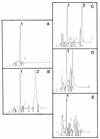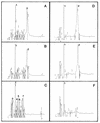Identification of OmpT as the protease that hydrolyzes the antimicrobial peptide protamine before it enters growing cells of Escherichia coli
- PMID: 9683502
- PMCID: PMC107389
- DOI: 10.1128/JB.180.15.4002-4006.1998
Identification of OmpT as the protease that hydrolyzes the antimicrobial peptide protamine before it enters growing cells of Escherichia coli
Abstract
The influence of extracytoplasmic proteases on the resistance of Escherichia coli to the antimicrobial peptide protamine was investigated by testing strains with deletions in the protease genes degP, ptr, and ompT. Only DeltaompT strains were hypersusceptible to protamine. This effect was abolished by plasmids carrying ompT. Both at low and at high Mg2+ concentrations, ompT+ strains cleared protamine from the medium within a few minutes. By contrast, at high Mg2+ concentrations, protamine remained present for at least 1 h in the medium of an ompT strain. These data indicate that OmpT is the protease that degrades protamine and that it exerts this function at the external face of the outer membrane.
Figures




Similar articles
-
Requirement of a large K+-uptake capacity and of extracytoplasmic protease activity for protamine resistance of Escherichia coli.Arch Microbiol. 1997 Feb-Mar;167(2-3):126-36. Arch Microbiol. 1997. PMID: 9133319
-
Substrate specificity of the Escherichia coli outer membrane protease OmpP.J Bacteriol. 2007 Jan;189(2):522-30. doi: 10.1128/JB.01493-06. Epub 2006 Nov 3. J Bacteriol. 2007. PMID: 17085556 Free PMC article.
-
Prevalence of ompT among Escherichia coli isolates of human origin.FEMS Microbiol Lett. 1992 Oct 1;76(1-2):51-6. doi: 10.1016/0378-1097(92)90362-r. FEMS Microbiol Lett. 1992. PMID: 1427004
-
Structural features, physiological roles, and biotechnological applications of the membrane proteases of the OmpT bacterial endopeptidase family: a micro-review.Membr Cell Biol. 1998;12(1):1-8. Membr Cell Biol. 1998. PMID: 9829254 Review.
-
Omptin proteins: an expanding family of outer membrane proteases in Gram-negative Enterobacteriaceae.Mol Membr Biol. 2007 Sep-Dec;24(5-6):395-406. doi: 10.1080/09687680701443822. Mol Membr Biol. 2007. PMID: 17710644 Review.
Cited by
-
Molecular engineering of antimicrobial peptides: microbial targets, peptide motifs and translation opportunities.Biophys Rev. 2021 Jan 21;13(1):35-69. doi: 10.1007/s12551-021-00784-y. eCollection 2021 Feb. Biophys Rev. 2021. PMID: 33495702 Free PMC article. Review.
-
Antimicrobial peptides: structure, functions and translational applications.Nat Rev Microbiol. 2025 Jul 11. doi: 10.1038/s41579-025-01200-y. Online ahead of print. Nat Rev Microbiol. 2025. PMID: 40646173 Review.
-
Cationic antimicrobial peptide resistance in Neisseria meningitidis.J Bacteriol. 2005 Aug;187(15):5387-96. doi: 10.1128/JB.187.15.5387-5396.2005. J Bacteriol. 2005. PMID: 16030233 Free PMC article.
-
Utilization of Escherichia coli outer-membrane endoprotease OmpT variants as processing enzymes for production of peptides from designer fusion proteins.Appl Environ Microbiol. 2004 Jan;70(1):76-86. doi: 10.1128/AEM.70.1.76-86.2004. Appl Environ Microbiol. 2004. PMID: 14711628 Free PMC article.
-
Engineering next generation proteases.Curr Opin Biotechnol. 2009 Aug;20(4):390-7. doi: 10.1016/j.copbio.2009.07.003. Epub 2009 Aug 24. Curr Opin Biotechnol. 2009. PMID: 19709875 Free PMC article. Review.
References
-
- Ando T, Watanabe S. A new method for fractionation of protamines and the amino acid sequences of one compound of salmine and three compounds of iridine. Int J Protein Res. 1969;1:221–224. - PubMed
-
- Ando T, Yamasaki M, Suzuki S. Protamines; isolation, characterization and function. New York, N.Y: Springer Verlag; 1973. pp. 58–80. - PubMed
-
- Aspedon A, Groisman E A. The antibacterial action of protamine: evidence for disruption of cytoplasmic membrane energization in Salmonella typhimurium. Microbiology. 1996;142:3389–3397. - PubMed
-
- Elish M E, Pierce J R, Earhart C F. Biochemical analysis of spontaneous fepA mutants of Escherichia coli. J Gen Microbiol. 1988;134:1355–1364. - PubMed
-
- Foxman B, Zhang L, Palin K, Tallmann P, Marrs C F. Bacterial virulence characteristics of Escherichia coli isolates from first time urinary tract infection. J Infect Dis. 1995;171:1514–1521. - PubMed
Publication types
MeSH terms
Substances
LinkOut - more resources
Full Text Sources
Other Literature Sources
Molecular Biology Databases

